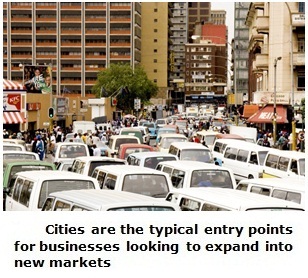 ReConnect Africa is a unique website and online magazine for the African professional in the Diaspora. Packed with
essential information about careers, business and jobs, ReConnect Africa keeps you connected to the best of Africa.
ReConnect Africa is a unique website and online magazine for the African professional in the Diaspora. Packed with
essential information about careers, business and jobs, ReConnect Africa keeps you connected to the best of Africa.



 While investors are already active in Africa’s 3 largest cities, a new report says that they should also be getting excited about the "Next 10" biggest cities in sub-Saharan Africa
While investors are already active in Africa’s 3 largest cities, a new report says that they should also be getting excited about the "Next 10" biggest cities in sub-Saharan AfricaGlobal investors are increasingly taking note of the untapped potential of sub-Saharan Africa, particularly its unparalleled demographic edge.
According to a new report by PricewaterhouseCoopers, Africa will be enjoying faster economic growth than any other region - and will have the world's biggest labour force.
Africa's growth potential - and its 'Next 10' biggest cities
Most major international corporations are already active in at least one of the three largest cities in sub-Saharan Africa - Lagos in Nigeria, Kinshasa in the Democratic Republic of Congo (DRC), and Johannesburg in South Africa.
However, PricewaterhouseCoopers (PwC) economists believe investors should also be getting excited about the "Next 10" biggest cities in sub-Saharan Africa, namely Dar es Salaam (Tanzania), Luanda (Angola), Khartoum (Sudan), Abidjan (Côte d'Ivoire), Nairobi (Kenya), Kano and Ibadan (Nigeria), Dakar (Senegal), Ouagadougou (Burkina Faso), and Addis Ababa (Ethiopia).
According to PwC's latest Global Economy Watch report, the population of these cities is projected to almost double by 2030, growing by around 32-million people. In fact, the latest UN projections indicate that, by 2030, two of the "Next 10" - Dar es Salaam and Luanda - could have bigger populations than London has now.
Cities are the typical entry points for businesses looking to expand into new markets, because they enable closer interaction with customers in a relatively small geographical area.
"The report projects that economic activity in the 'Next 10' cities could grow by around US$140-billion by 2030," Stanley Subramoney, strategy leader for PwC's south market region, said in a statement. This is roughly equivalent to the current annual output of Hungary, Subramoney said, adding that this was a conservative estimate that did not take into account real exchange rate appreciation, despite relatively strong projected growth in these economies.
Roelof Botha, economic adviser to PwC, said that, in addition to high rates of GDP growth, rapid urbanisation and the so-called demographic edge, "a number of other economic phenomena in the region are starting to appeal to the global investment community".
These include:
It was factors such as these which had seen a return to sound growth in foreign direct investment (FDI) inflows into a number of key African economies last year, Botha said.
Poor Infrastructure and ‘Growing Pains’
However, according to PwC, there are three issues that sub-Saharan Africa has been struggling to resolve for a number of decades, and which could slow the pace at which the "Next 10" cities grow.
These are: the low quality of "hard" infrastructure like roads and railways; inadequate "soft" infrastructure like schools and universities: and "growing pains" arising from political, legal and regulatory institutions struggling to deal with bigger, more complicated economies.
"The challenges that policy makers face is to convert Africa's demographic dividend into economic reality by overcoming these hurdles," Subramoney said, adding: "History suggests this will not be a quick or easy process. Infrastructure development is a key driver for progress across Africa and a critical enabler for sustainable and socially inclusive growth.
"However, investors should form their own plans to mitigate these problems by supporting infrastructure skills and development programmes."
This article was first published on SouthAfrica.Info – www.SouthAfrica.info
Photo: Chris Kirchhoff, MediaClubSouthAfrica.com
